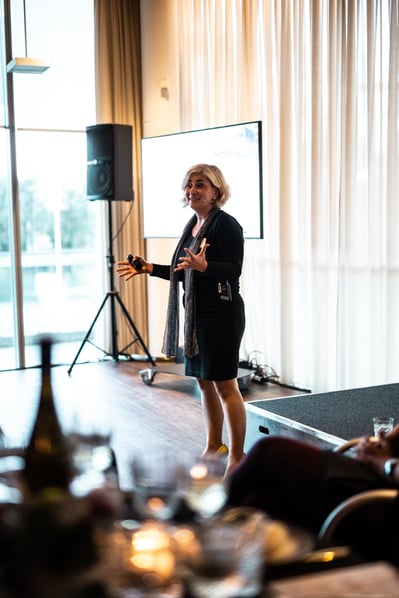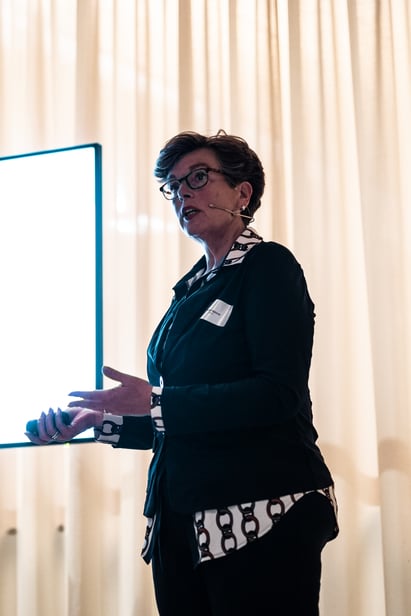


It’s so much fun like old times again,” Ingelou Stol makes her entrance into the room during the Fe+male Tech Heroes dinner. Together with Hilde de Vocht, Stol welcomes the one hundred guests, mostly women. They are all given the opportunity to introduce themselves. Within 10 minutes, the founders of the network know how to work the room and get through all the guests. “Your name and where you work,” Stol says. The theme of the evening is: The sky is the limit? It is reflected in the décor of the room, with gold stars on the tables and a menu card that refers to Icarus, a figure from Greek mythology who ‘fell from the sky’.
The evening’s speakers have also geared their stories towards the theme. They are Oana van der Togt, Senior Business Developer Manager at the Dutch TNO research organization and member of the Council for Diversity and Inclusion at TNO, and Margot Nijkamp-Diesfeldt who developed EcoSystem Game, is a writer and also the director of ESTI, EcoSystem Thinking Institute. Both women let the audience know that the sky is definitely not the limit.
Spoken language
The Romanian Oana van der Togt came to the Netherlands for a year as a physics student on an exchange program. That was back in 1999. She did an internship at TU Delft and had no intention of staying in the Netherlands. But after her graduation, once she was back in Romania, she received a phone call. Whether she wanted to carry on with her research into semi-conductors, as part of a PhD study. She did not have to think about that for very long. Wholeheartedly, she said “yes. This time she planned to stay for four years. Then she met her present husband three months before she was due to leave.
So she stayed and applied for a job at TNO. One floor up from where she worked at TU Delft. “But a totally different world,” van der Togt notes. At TU Delft, she had worked in an international environment with English as the main language. At TNO: 4 foreigners out of 350 employees, 4 of them women, including the secretary. “It was a complete culture shock and a communication shock. Dutch was spoken at all times. While I had told them during my job interview that my Dutch was just good enough to get by in the supermarket.”
A crash course in Dutch followed, since, says Van der Togt, “I wanted to prove that I could do it.” In retrospect, she would never do that again. “In a work environment, it’s important to know the nuances of a language to be able to express yourself effectively in a discussion. My advice to newcomers in the Netherlands: Only start speaking Dutch at work if you have really mastered it. Searching for words means that will always fall behind in a discussion.”
Unplanned
Van der Togt developed herself within TNO from an optical designer to a project manager and subsequently a program manager and business developer. All within the semiconductor world. In 2016, she made the move to aerospace. She is now responsible for customers like the European Space Agency and NASA. A market she knew nothing about when she first started out.
Looking back, this was not a planned move. As a talent within the semiconductor branch, she had earned her stripes, Van der Togt explains. A colleague asked her, as a business developer in semiconductors, to go with him to an ESA meeting. One of the other participants was late as he was having a major crisis. That was the explanation, and Van der Togt’s colleague let her know that he did have a solution and that he also had a presentation that could show that as well. Van der Togt arranged a time slot for him to speak. She came back to TNO with a contract with the ESA. Something that was unprecedented, certainly within the research organization.
Oana van der Togt © House of Yellow
‘No’ is not an option
Since she had managed to do that, the director of aerospace at TNO asked her to “open new doors” for his department. There she was, the youngest person sitting at the table, without any knowledge of all the technical terms and processes involved in aerospace. “But I had the confidence of my director and I knew what I could do. All I had to do was show it.”
Van der Togt grew up in communist Romania. Both her father and mother worked full time, as did the other mothers in her neighborhood. Although the Romanian later learned that everyone was obligated to work, as a young girl she knew no better than that “no is not an option.” “As long as you put your mind to it. Failure was not an option. Women in engineering are very normal in Romania.”
Needless to say, the Netherlands has changed her. “I communicate much more directly nowadays. When I go back to Romania I have to backtrack and tell myself: ‘Chill, Oana.’ But she has kept her style of leadership, which she describes as inclusive. “I always want to hear everyone’s opinion. Also the quiet voice in the room. My team knows what they can expect from me, so do my clients. I try my hardest for them, but if the answer is no, it is no. Even if something hasn’t gone as planned, I’ll readily admit it. Open and honest, that’s how I am.”
Intuition
Margot Nijkamp-Diesfeldt also had no predetermined plan for her career. She “stumbled” into various jobs and evolved from executive secretary at Stork, via Packard Bell – “the one of the first home computers” -, E-One – “the one of the sexiest fire trucks” – to being an HR and Communications manager and then a director.
She arrived at the High Tech Campus Eindhoven in 2005 without a technical background. Her husband thought she was perfect for the position of HR and Operations Director at the newly established Holst Centre. The vacancy was briefly shoved under her nose every morning. Nijkamp was determined to finish her MBA studies before she switched jobs. Nonetheless, she decided to send in her CV. Less than five hours later she received a reply: Her profile was a perfect fit. She went for an interview, became enthusiastic and made it through to the assessments. They were tough and she doubted whether the scientific world would suit her, “but I followed my intuition. She got the job and, later as director of SME relations, would remain there until the end of 2011.
EcoSystem Game
During this time, she overcame two life-changing crises. “I had a ‘terminal phobia’ of public speaking,” Nijkamp confesses. “I really can’t explain to you how extreme that was.” Her boss at Holst Centre, Jo De Boeck, said: “But Margot, it’s precisely that that’s not going to help you in your career.” She did some very unique things there, De Boeck told her. He was not the one to talk about that, instead, she was. She reluctantly went in front of an audience, but on two occasions froze so badly that she was not even able to drink water. She had not slept a wink the previous nights either.
A breakthrough came when she met Carolien De Kreij-Goudriaan, who was at Kirkman Company at the time. Nijkamp was invited to speak and came up with a way to interact with her audience. She designed a game. “My passion is writing. I outlined some roles and tasks and had people play the game first. Then I explained what they had done.” Her game caught on, people got excited and of the 40, 20 of them asked her to come do the same thing at their organization as well. It was the start of what is now the EcoSystem Game.
“I had written those roles in a really fun way. With a good dose of humor. That allowed people to really experience what it is like to work on innovation at the Holst Centre. At the same time, I had been able to interact with a lot of people. That worked. Now you can put me in front of a room of 100 people and I’ll read that room in 3 minutes.”
Margot Nijkamp – Diesfeldt @ House of Yellow
Two big dreams
During Fe+male Tech Heroes, Nijkamp also manages to captivate her audience with her own personal story. There’s an even more pronounced hush in the room as she talks about her second crisis to the audience. It was one she had not seen coming, she states. At the end of 2010, she was told she could expect to live only another four to six months. ” That’s a real crisis,” she recalls. That crisis led her to think about what she still wanted to do. She had two big dreams back then. “I wanted to create a start-up with zero euros and become a published author. So I started writing like crazy on my first novel.”
Under the pseudonym Emma Flogard – a Scandinavian surname that refers to keeping a watchful eye on your flow – All I’ve Got was published. Through the Holst Centre, she set up the Red BlueJay Foundation as a spin-off. What she had learned up to that point was that people are more than what they put on their CVs. In her work with the Holst Centre and others, she developed a work climate with room for the people factor, one with strong feminine cultural overtones, as Nijkamp puts it. “If that creates common ground, it creates the space to work together on innovation.” It forms the basis of the game that she developed and continued on with within Red BlueJay.
“People told me I was crazy for wanting to start a business for myself while undergoing all those grueling treatments. But for me, there was no other time to do that, it was really now or never.” In the end, the diagnosis turned out to be partly wrong and Nijkamp still has her feet firmly on the ground. She wrote another poetry co;;ection (Stripe code of lashes) and her book Samenscholing Geboden appeared under her own name. “It was published even before corona turned up,” Nijkamp is quick to add.
From day to day
Her foundation also continued to evolve into ESTI, EcoSystem Thinking Institute, where she works with her business partner Rick Wielens and team for clients such as the Dutch Ministry of Defence, Unilever, the Province of Gelderland and the University of Amsterdam. Things are going well for her. Even though she is in pain 24 hours a day, no one notices it about her. She is hypermobile and has Hemochromatosis, an iron overload disease. “Physically, I can’t do much. That makes me mentally inexhaustible.”
Last Valentine’s Day, she handed out more than 1,000 poetry collections to seniors and people in care in her neighborhood. “To let them know there’s always someone thinking of them.” Since then, she has been asked to come and read out loud. Just last weekend too. “Then I go and come home an hour and a half later than I anticipated. Tired, but still enough energy for a walk with my 10-week-old puppy.”
“If you had told me 35 years ago, when I was working as a secretary at Stork, that I would now be the director of a foundation and writing books, I would have laughed at you outright. I don’t have a dream of where it will all eventually lead, I live from day to day. However, each time I make a decision with my team as to whether what we do at ESTI has any social impact. Every cent we earn goes back into the foundation.”
This article was written by Corine Spaans of Innovation Origins.
